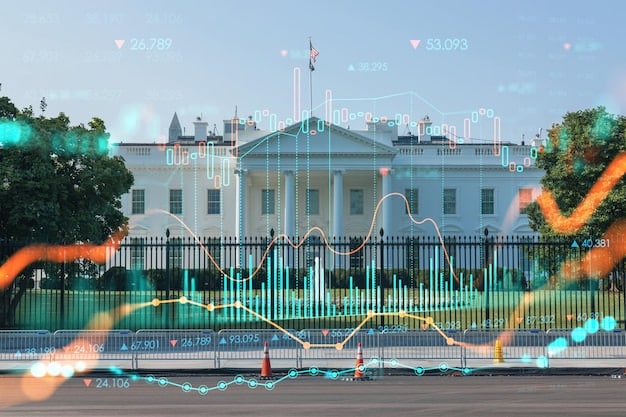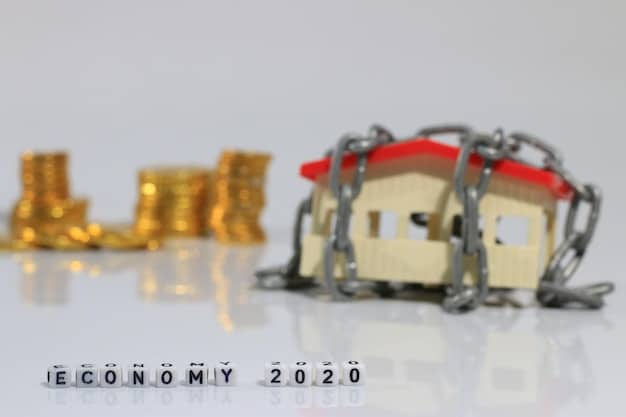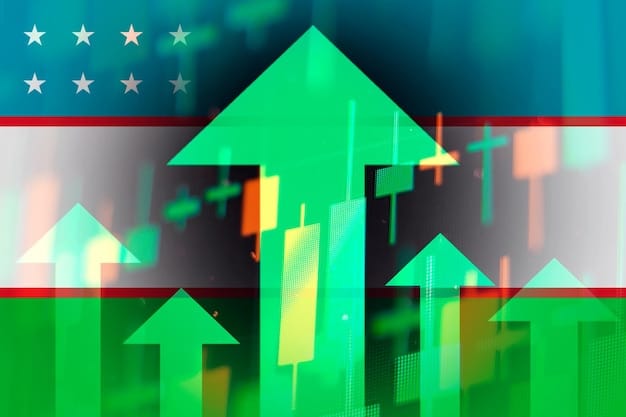US Federal Reserve Rate Hikes: Mortgage Rate Impacts in 2025

The US Federal Reserve’s interest rate hikes have a direct impact on mortgage rates, influencing the affordability of homes and shaping the real estate market in 2025 through increased borrowing costs for prospective homeowners.
Understanding how the US Federal Reserve’s interest rate hikes impact mortgage rates in 2025 is crucial for anyone considering buying a home, investing in real estate, or simply wanting to grasp the economic forces shaping the housing market.
Understanding the Federal Reserve’s Role
The Federal Reserve, often called the Fed, plays a central role in the US economy. Its decisions, particularly concerning interest rates, ripple through various sectors, and the housing market is no exception.
Here’s a closer look at the Fed’s mandate and how its actions influence the broader financial landscape:
The Fed’s Dual Mandate
- Maximum Employment: The Fed aims to promote a healthy labor market with low unemployment rates.
- Price Stability: The Fed strives to maintain stable prices, controlling inflation to prevent the erosion of purchasing power.
How the Fed Influences Interest Rates
- Federal Funds Rate: The Fed sets the target range for the federal funds rate, the interest rate at which commercial banks lend to each other overnight.
- Discount Rate: The Fed also sets the discount rate, the interest rate at which commercial banks can borrow money directly from the Fed.
- Open Market Operations: The Fed buys and sells government securities to influence the money supply and credit conditions.
These tools allow the Fed to manage inflation and steer the economy towards its dual mandate goals. However, its actions have consequences for mortgage rates, impacting the affordability of housing for millions of Americans.

In conclusion, the Federal Reserve’s influence extends far beyond Wall Street, directly affecting Main Street and the ability of individuals to achieve the dream of homeownership.
The Connection Between Fed Rate Hikes and Mortgage Rates
The direct connection between the Federal Reserve’s rate hikes and mortgage rates is a critical element to understand. When the Fed raises its benchmark rate, it typically leads to higher borrowing costs across the board, including for mortgages.
Here’s how the mechanism works and why it matters:
The Ripple Effect
- Increased Borrowing Costs: When the Fed raises the federal funds rate, banks and other financial institutions generally increase their lending rates to reflect the higher cost of borrowing money.
- Impact on Mortgage-Backed Securities: Mortgage rates are closely tied to the market for mortgage-backed securities (MBS). When the Fed raises rates, the yield on MBS tends to increase, pushing mortgage rates higher.
Historical Evidence
- Past Trends: Historically, there has been a strong correlation between the federal funds rate and mortgage rates. While the relationship isn’t always one-to-one, Fed rate hikes tend to lead to increases in mortgage rates.
- Market Expectations: Anticipation of Fed rate hikes can also influence mortgage rates. If the market expects the Fed to raise rates, lenders may proactively increase mortgage rates in anticipation of higher borrowing costs.
The connection between Fed rate hikes and mortgage rates highlights the central bank’s ability to influence the housing market. Understanding this link is crucial for potential homebuyers and investors looking to navigate the market in 2025.
In conclusion, the relationship between Fed rate hikes and mortgage rates is undeniable. While other factors can influence mortgage rates, the Fed’s actions remain a primary driver.
Predicting Fed Actions in 2025
Predicting the Federal Reserve’s actions is a complex task, but understanding the factors that influence their decisions can provide valuable insights. Keep in mind that economic forecasts are not guarantees, but rather informed estimates based on available data and trends.
Here are the key economic indicators and events to watch for:
Key Economic Indicators
- Inflation Rate: The Fed closely monitors inflation data, such as the Consumer Price Index (CPI) and the Personal Consumption Expenditures (PCE) price index. If inflation remains above the Fed’s target of 2%, it may be more likely to raise rates.
- Unemployment Rate: The Fed also considers the unemployment rate when making policy decisions. A strong labor market with low unemployment could put upward pressure on wages and prices, potentially leading the Fed to raise rates.
- GDP Growth: The overall health of the economy, as measured by gross domestic product (GDP) growth, is another important factor. Strong economic growth could prompt the Fed to raise rates to prevent overheating.
Geopolitical Events
- Global Economic Conditions: Events in other countries can also influence the Fed’s decisions. A slowdown in global economic growth or a financial crisis could lead the Fed to hold off on raising rates.
- Trade Policies: Changes in trade policies can also affect the US economy and inflation. Trade wars or new tariffs could lead to higher prices, potentially prompting the Fed to respond.
By monitoring these indicators and events, potential homebuyers and investors can get a better sense of the Fed’s likely course of action in 2025 and its potential impact on mortgage rates. Staying informed is crucial for making sound financial decisions in an ever-changing economic landscape.

In conclusion, predicting the Federal Reserve’s actions is an ongoing process that requires careful analysis of economic data and global events. Being aware of these factors can help one prepare for potential shifts in the mortgage market.
Potential Mortgage Rate Scenarios for 2025
Based on various economic forecasts and potential Federal Reserve actions, several mortgage rate scenarios could unfold in 2025. It’s essential to consider these possibilities when planning for a home purchase or refinance.
Here are a few potential scenarios:
Scenario 1: Stable Rates
In this scenario, inflation remains under control, and the economy experiences moderate growth. The Fed may choose to hold interest rates steady, leading to relatively stable mortgage rates. This could create a favorable environment for homebuyers, with predictable borrowing costs.
Scenario 2: Gradual Rate Increases
- Description: If inflation persists or the economy accelerates, the Fed may implement gradual interest rate increases. This would likely lead to a corresponding rise in mortgage rates, but at a measured pace.
- Impact: Homebuyers would need to adjust their budgets to account for higher borrowing costs, and the housing market could experience a slight slowdown.
Scenario 3: Rapid Rate Hikes
This scenario involves a more aggressive response from the Fed to combat high inflation or an overheating economy. Rapid rate hikes would likely cause a sharp increase in mortgage rates, potentially cooling the housing market significantly. Homebuyers may face affordability challenges, and refinancing opportunities could become limited.
In summary, the mortgage rate landscape in 2025 remains uncertain, but understanding these potential scenarios can help individuals make informed decisions and navigate the housing market effectively.
Strategies for Homebuyers in a Rising Rate Environment
If mortgage rates rise in 2025, potential homebuyers will need to adapt their strategies to maintain affordability and achieve their homeownership goals. There are several steps one can take to mitigate the impact of higher borrowing costs.
Here are some strategies to consider:
Improve Your Credit Score
- Explanation: A strong credit score can help you qualify for a lower interest rate, even in a rising rate environment.
- Action Steps: Check your credit report for errors, pay bills on time, and reduce your credit utilization ratio.
Save for a Larger Down Payment
A larger down payment reduces the amount you need to borrow, lowering your monthly mortgage payments and potentially qualifying you for a better interest rate.
Consider an Adjustable-Rate Mortgage (ARM)
- Description: ARMs typically offer lower initial interest rates than fixed-rate mortgages. However, the rate can adjust over time, so it’s important to understand the terms and potential risks.
- Caution: ARMs can be a good option if you plan to sell or refinance before the rate adjusts, but they carry the risk of higher payments if rates rise.
Staying flexible and informed is key to successfully navigating the housing market. Being proactive and taking steps to improve one’s financial position can increase the chances of achieving homeownership.
Long-Term Effects on the Housing Market
US Federal Reserve’s interest rate hikes in 2025 may have long-lasting effects on the housing market, influencing home prices, sales volume, and overall market dynamics.
Here are some potential long-term consequences:
Slower Home Price Appreciation
Higher mortgage rates can dampen demand for homes, leading to slower price appreciation or even price declines in some markets. This could benefit buyers in the long run, as homes become more affordable.
Reduced Sales Volume
Rising rates can also reduce the number of homes sold, as some potential buyers may be priced out of the market. This could lead to a more balanced market, with fewer bidding wars and more inventory.
Shift in Housing Preferences
As affordability becomes a greater concern, buyers may shift their preferences towards smaller homes, condos, or more affordable locations. This could lead to changes in the types of properties that are in demand.
It is important to remember that the housing market is subject to numerous factors, and the long-term effects of rate hikes can vary depending on local conditions and economic trends. Keeping a long-term perspective and being prepared to adapt to changing market conditions is crucial for both buyers and sellers.
| Key Point | Brief Description |
|---|---|
| 🏠 Rate Hikes | Increased borrowing costs for mortgages. |
| 📈 Economic Indicators | Inflation, unemployment, and GDP influence Fed decisions. |
| 💰 Homebuyer Strategies | Improve credit, save more, consider ARMs. |
| 📉 Housing Market | Slower price growth, reduced sales. |
Frequently Asked Questions
▼
Higher mortgage rates increase monthly payments, making it harder for first-time buyers to afford a home. They may need to adjust budgets or delay their purchase.
▼
An ARM has an interest rate that can change over time based on market conditions, potentially leading to higher or lower monthly payments.
▼
Improving your credit score, saving for a larger down payment, and shopping around for the best rates are all effective strategies.
▼
Keep an eye on inflation rates, unemployment figures, and GDP growth to gauge the Fed’s likely actions and their impact on mortgage rates.
▼
While rising rates can cool the market, a crash is not guaranteed. The impact depends on various factors, including housing supply and overall economic conditions.
Conclusion
Understanding the intricate relationship between the Federal Reserve’s rate hikes and mortgage rates is essential for navigating the housing market in 2025. By staying informed, planning strategically, and adapting to changing conditions, potential homebuyers and investors can make sound financial decisions and achieve their goals.





